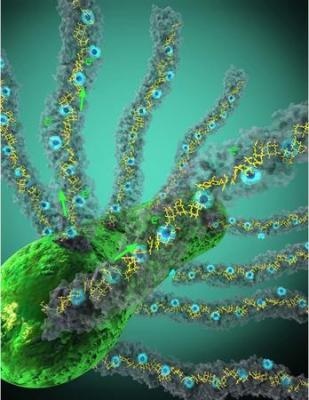Deep underground or in the ocean, where oxygen is not present, Geobacter bacteria “breathe” by projecting miniature protein filaments known as “nanowires” into the soil, to dispose of surplus electrons ensuing from the conversion of nutrients to energy.
 (Image credit: Yale University)
(Image credit: Yale University)
These nanowires allow the bacteria to carry out environmentally vital operations such as cleaning up radioactive sites and producing electricity. Scientists have known for a long time that Geobacter makes conductive nanowires – 1/100,000 the width of a human hair – but so far no one had discovered what they are composed of and the reason behind their conductive capability.
Scientists at Yale, University of Virginia, and the University of California at Irvine have published a new study in the April 4th issue of the journal Cell, which reveals a surprise: the protein nanowires contain a core of metal-containing molecules known as hemes.
Earlier not one person suspected such a structure. Using high-resolution cryo-electron microscopy, the scientists were able to observe the nanowire’s atomic structure and learn that hemes line up to form a continuous path along which electrons move.
“This study solves a longstanding mystery of how nanowires move electrons to minerals in the soil,” said lead author Nikhil Malvankar, assistant professor of molecular biophysics and biochemistry at Yale and a faculty member at the Microbial Sciences Institute.
“It is possible we could use these wires to connect cells to electronics to build new types of materials and sensors.”
Edward Egelman of Virginia and Allon Hochbaum of UC-Irvine are other senior authors. Fengbin Wang of Virginia and Yale’s Yangqi Gu are co-first authors. Other authors include Yale’s Patrick O’Brien, Sophia Yi, Sibel Ebru Yalcin, Vishok Srikanth, Cong Shen, Dennis Vu, and UC Irvine’s Nicole Ing.

